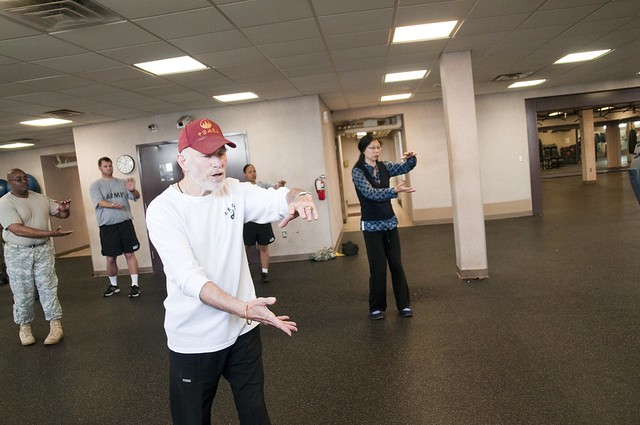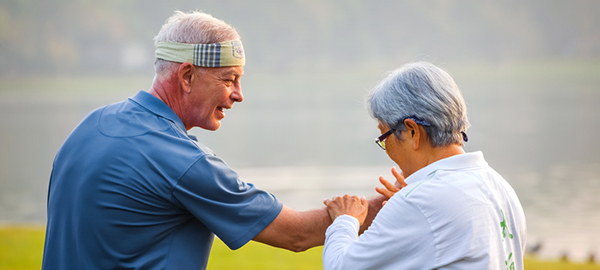
Osteoarthritis (OA) is a degenerative disease that affects the joints, resulting in swelling, pain, and stiffness in the knees, hips, hands, and spine. It is the most common type of arthritis affecting 16%-33% of older adults.
Since OA is a progressive disease with no known cure, treatments only aim to relieve the symptoms and improve the mobility and quality of life of patients. Aside from taking pain relief and anti-inflammatory medications, it has been shown that doing Tai Chi can significantly improve the condition of patients with OA.
Tai Chi is a form of Chinese martial art which, aside from providing self-defense training, is also known for its numerous health benefits including busting stress, improving balance, strength, and endurance, and also preventing fall-related injuries.
It combines deep diaphragmatic breathing with a series of slow, flowing, rhythmic, and graceful movements for the purpose of finding that inner peace.
A Brief Background on Osteoarthritis
Because of injury, old age or obesity, your cartilage (a slippery tissue which cushions and covers the ends of bones in your joint) wears down over time. It functions as a shock absorber and ensures frictionless motion in the joints.
The deterioration of joint cartilage makes your bones rub together. This will result in various signs and symptoms that only worsen over time. Pain, tenderness, stiffness, limited range of motion, bone spurs, and a grating sensation are just some of the most common manifestations of OA.
How Tai Chi Can Help With Osteoarthritis
Tai Chi is often recommended as part of a treatment program and this is mostly used during the early stages of osteoarthritis. Researchers have also found out that this method can provide more symptomatic relief and improvement as compared to physical therapy.
If you’re suffering from knee OA and you practice Tai Chi for one hour at least twice a week, you may experience pain relief that allows you to function better and attend to your daily activities with less discomfort.
Aside from these physical benefits, Tai Chi can also boost your self-esteem, improve your mood, and reduce the risk of suffering from depression. Attending 12 weeks of Tai Chi classes can have lasting benefits for up to a year.
One of the main purposes of Tai Chi is to build enough strength in certain muscle groups for patients with knee OA. This is necessary in order to have adequate knee support, leading to lesser knee stress. This can be accomplished by doing low-impact and focused movements.
What Else Can Tai Chi Do?
There are several aspects incorporated into every Tai Chi movement including strength training, meditation, support, breathing, and mindfulness. On top of promoting a sense of well-being, it also helps OA patients through the following means:
- As a non-pharmacologic and non-invasive OA intervention
- Improves muscle strength, support, and flexibility
- Better coordination
- Relaxes tense muscles and joints
- Increases range of motion
- Reduces pain
- Relieves joint stiffness
- Improves joint stability and overall function
- Induces calmness and serenity
- Provides balance training
- Improves heart and lung functions
- Has very little side effects
- Helps with relaxation through visualization and mindfulness
- Sharpens your focus
- Lowers stress and anxiety
- Improves sleep
An important benefit of attending Tai Chi classes is also gaining social support which can boost your self-confidence. Besides, the presence of an instructor can ensure that you will not end up injuring yourself while executing the movements.
Additional Safety Tips
Listen to your body. Do not push yourself too hard especially if you’re only starting out. You must understand that there are movements you cannot yet do as a beginner. You need to rest if you suddenly feel uncomfortable, exhausted or in pain.
- Choose a knowledgeable and experienced instructor. It’s much better if he/she has worked with osteoarthritis patients before.
- Wear a knee brace for osteoarthritis while doing Tai Chi for additional knee stabilization and support. Knee braces are generally suitable for all levels of activity and body movements included in Tai Chi.
- Warm-up and cool-down to prepare your joints and prevent any injury.
- Listen to your body. Do not push yourself too hard especially if you’re only starting out. You must understand that there are movements you cannot yet do as a beginner. You need to rest if you suddenly feel uncomfortable, exhausted or in pain.
- Don’t take your classes on an empty or full stomach
Tai Chi has some similarity with yoga in terms of the fluidity of movements and the health benefits. Remember that the goal of every treatment for osteoarthritis is to alleviate the symptoms and improve joint function. Tai Chi has been proven to be effective in both. Though more and more people are turning to Tai Chi instead of physical therapy, always make it a practice to consult with your doctor before starting any activity.
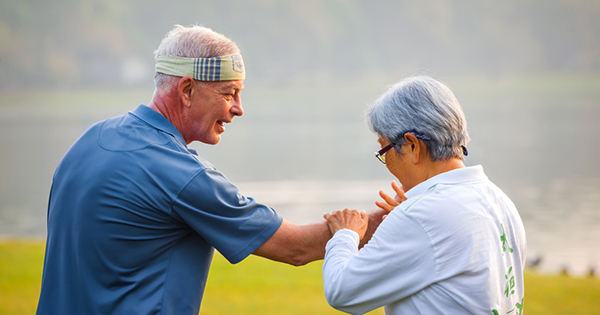
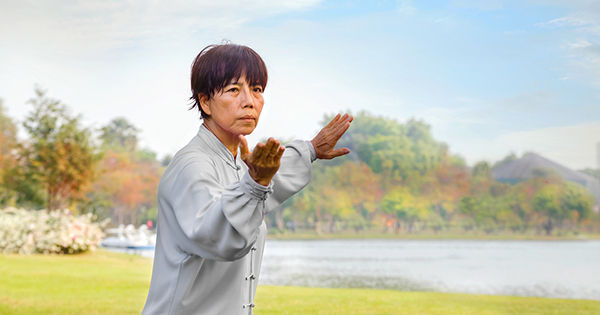
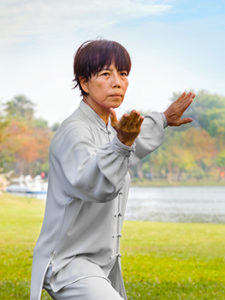 The ancient martial art Tai Chi, long a means of gentle, meditative exercise, is riding a recent wave of popularity by physical therapists and other individuals interested in using it to rehabilitate injuries and promote health. Tai Chi, which has roots dating back to 13th century China, has been the most popular health regimen to keep an aging population healthy in China, as it requires no special equipment and can be done almost anywhere. Roughly 200 million people practice Tai Chi today, and that number is growing as more people discover the effectiveness of its low-impact, low stress movement. There are five different types of Tai Chi, Chen-style, Yang-style, Wu- or Wu (Hao)-style, Wu-style and Sun-style. It is usually thought of in conjunction with Qi Gong, which has been called the “grammar” of Tai Chi due to its focus on tiny movements.
The ancient martial art Tai Chi, long a means of gentle, meditative exercise, is riding a recent wave of popularity by physical therapists and other individuals interested in using it to rehabilitate injuries and promote health. Tai Chi, which has roots dating back to 13th century China, has been the most popular health regimen to keep an aging population healthy in China, as it requires no special equipment and can be done almost anywhere. Roughly 200 million people practice Tai Chi today, and that number is growing as more people discover the effectiveness of its low-impact, low stress movement. There are five different types of Tai Chi, Chen-style, Yang-style, Wu- or Wu (Hao)-style, Wu-style and Sun-style. It is usually thought of in conjunction with Qi Gong, which has been called the “grammar” of Tai Chi due to its focus on tiny movements.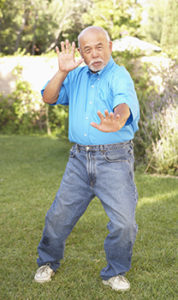 In one study comparing men over the age of 65 with at least ten years experience doing Tai Chi (and no other form of exercise) against a group of sedentary men, it was found that the Tai Chi practitioners scored better on tests of flexibility, cardiovascular function and balance. Another study, which focused on individuals with mild balance disorders, found that after eight weeks of Tai Chi training, significant improvement in performance on a standard balance test was noted. Researchers also found that Tai Chi decreases fear of falling and increases self-confidence in those who practice who are over the age of 70; fully 54% of those studied cited improved balance as the reason for their increased self-confidence. This self-confidence appears to be correlated with motivation to continue exercising, long viewed as a key factor in maintaining health among the elderly.
In one study comparing men over the age of 65 with at least ten years experience doing Tai Chi (and no other form of exercise) against a group of sedentary men, it was found that the Tai Chi practitioners scored better on tests of flexibility, cardiovascular function and balance. Another study, which focused on individuals with mild balance disorders, found that after eight weeks of Tai Chi training, significant improvement in performance on a standard balance test was noted. Researchers also found that Tai Chi decreases fear of falling and increases self-confidence in those who practice who are over the age of 70; fully 54% of those studied cited improved balance as the reason for their increased self-confidence. This self-confidence appears to be correlated with motivation to continue exercising, long viewed as a key factor in maintaining health among the elderly.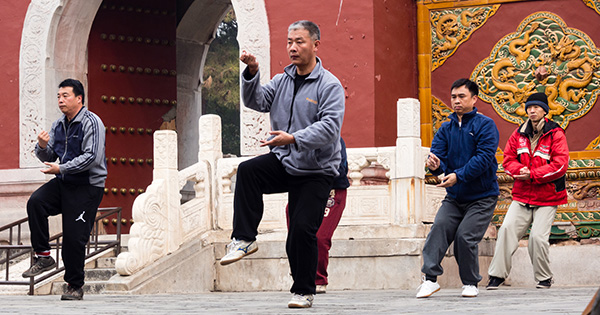
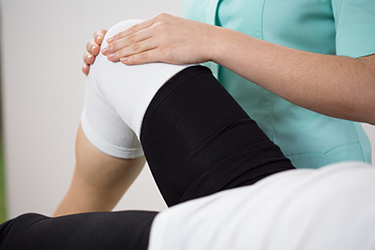 No matter what exercise you do, remember you don’t want to rotate your knees. Unlike your hips or ankles, your knees are hinge joints and not designed to rotate. Also, there can be several different reasons that can cause knee pain. If there is an underlying issue, exercises may or may not relieve the pain but that will not be long lasting, so know and treating the cause is important.
No matter what exercise you do, remember you don’t want to rotate your knees. Unlike your hips or ankles, your knees are hinge joints and not designed to rotate. Also, there can be several different reasons that can cause knee pain. If there is an underlying issue, exercises may or may not relieve the pain but that will not be long lasting, so know and treating the cause is important. 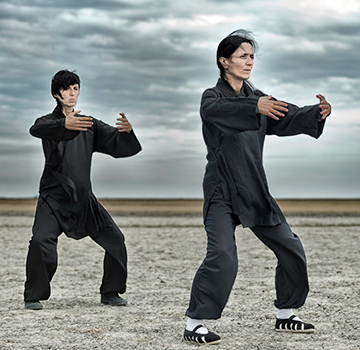 Probably one of the best tai chi exercises for knee rehabilitation. Just as the name suggests, the workout mimics the stance as if you’re riding a horse. Stand with your knees stretched slightly wider than your shoulders, feet right under the knees and pointing straight ahead, and from there try to round your crotch like you’re on a horse by bending a little and relaxing the knees. Hold your arms in front of you at the level of your heart, with elbows bent at about 40 degrees as if you’re hugging a tree. This stance gives this exercise it another name, i.e. hug the dree. Sink your shoulder, avoid leaning forward, keep your back straight, and gently pull your chin in. The goal is to hold this stance for 20 minutes, but as a beginner don’t worry if you get fatigued far earlier.
Probably one of the best tai chi exercises for knee rehabilitation. Just as the name suggests, the workout mimics the stance as if you’re riding a horse. Stand with your knees stretched slightly wider than your shoulders, feet right under the knees and pointing straight ahead, and from there try to round your crotch like you’re on a horse by bending a little and relaxing the knees. Hold your arms in front of you at the level of your heart, with elbows bent at about 40 degrees as if you’re hugging a tree. This stance gives this exercise it another name, i.e. hug the dree. Sink your shoulder, avoid leaning forward, keep your back straight, and gently pull your chin in. The goal is to hold this stance for 20 minutes, but as a beginner don’t worry if you get fatigued far earlier.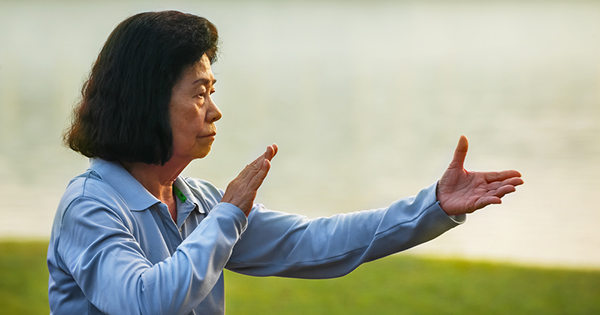
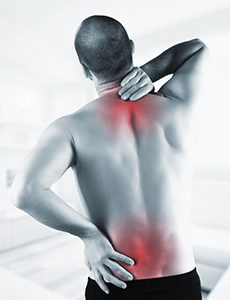 Most people associate tai chi with groups of people in parks who move very slowly in unison. Such controlled movement has some significant benefits for your back. Yoga works wonders for many people, but its lack of movement sometimes prevents dramatic results in terms of back pain. Likewise, running is very good for many people, but the jarring motion can exacerbate back pain instead of relieving it.
Most people associate tai chi with groups of people in parks who move very slowly in unison. Such controlled movement has some significant benefits for your back. Yoga works wonders for many people, but its lack of movement sometimes prevents dramatic results in terms of back pain. Likewise, running is very good for many people, but the jarring motion can exacerbate back pain instead of relieving it.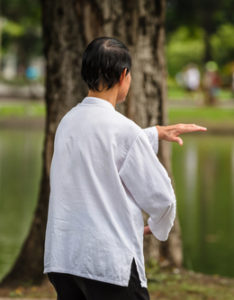 The physical benefits of tai chi often emerge after several months of sustained practice, but the stress relief benefits are often apparent almost immediately. The stretching-and-releasing motion promotes physical relaxation. As a bonus, the tools learned in tai chi may be effective during those parts of the day when stress levels are at their highest. Furthermore, the deep breathing and soft commands from the instructor promote mental relaxation, extending stress relief even further in many cases.
The physical benefits of tai chi often emerge after several months of sustained practice, but the stress relief benefits are often apparent almost immediately. The stretching-and-releasing motion promotes physical relaxation. As a bonus, the tools learned in tai chi may be effective during those parts of the day when stress levels are at their highest. Furthermore, the deep breathing and soft commands from the instructor promote mental relaxation, extending stress relief even further in many cases.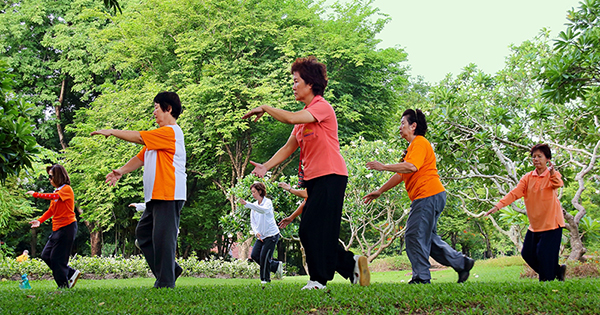
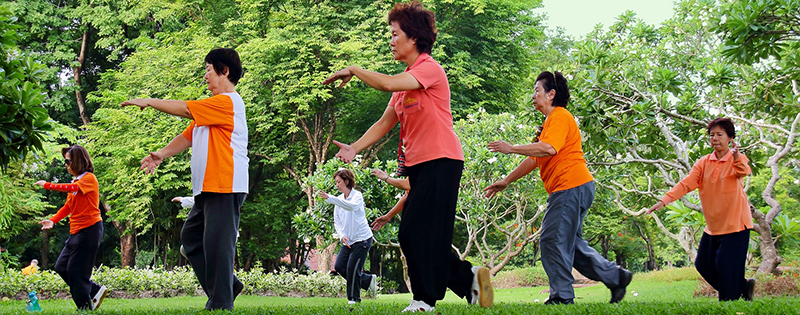
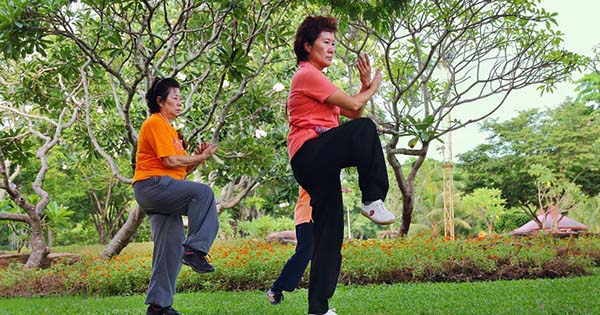
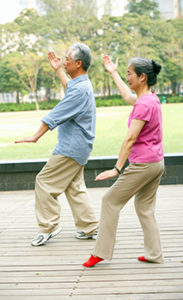 Before the tai chi wave washed ashore here in the United States, “physical exercise” was almost always synonymous with “physical exertion” and perhaps even “physical exhaustion.” After all, no pain no gain, right?
Before the tai chi wave washed ashore here in the United States, “physical exercise” was almost always synonymous with “physical exertion” and perhaps even “physical exhaustion.” After all, no pain no gain, right?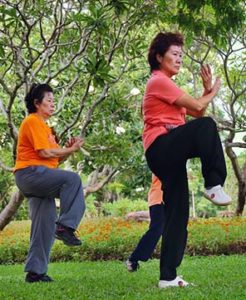 Tai chi to the rescue, because almost everyone can stand and move. Even if these things are not possible, there are many aquatic tai chi classes available, as well as other options for those with mobility impairments.
Tai chi to the rescue, because almost everyone can stand and move. Even if these things are not possible, there are many aquatic tai chi classes available, as well as other options for those with mobility impairments.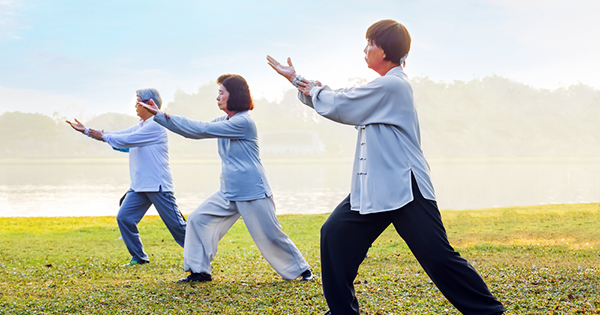
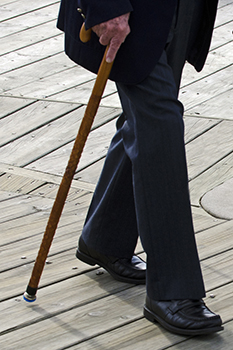 Many of us take the ability to put one foot in front of the other without falling over completely for granted. But for many people, this simple task that most of us perform thousands of times a day seems like a mountain that’s impossible to climb.
Many of us take the ability to put one foot in front of the other without falling over completely for granted. But for many people, this simple task that most of us perform thousands of times a day seems like a mountain that’s impossible to climb.
